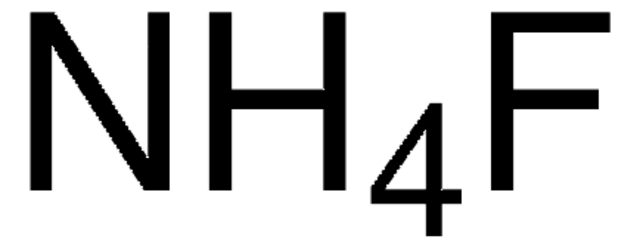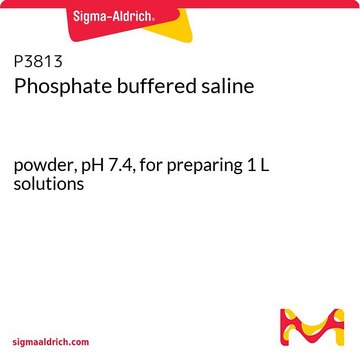338869
Ammonium fluoride
≥99.99% trace metals basis
Sinonimo/i:
Ammonia Hydrofluoride, Azanium fluoride
About This Item
Prodotti consigliati
Grado
for analytical purposes
Livello qualitativo
Saggio
≥99.99% trace metals basis
Stato
crystals and lumps
Impurezze
≤100 ppm METAL TRACE ANALYSIS (ICP)
Stringa SMILE
N.F
InChI
1S/FH.H3N/h1H;1H3
LDDQLRUQCUTJBB-UHFFFAOYSA-N
Cerchi prodotti simili? Visita Guida al confronto tra prodotti
Categorie correlate
Descrizione generale
Applicazioni
- To modify the interface between the electron transport layer and the perovskite layer of solar cells. This helps to reduce interfacial defects and charge recombination enhancing power conversion efficiency of perovskite solar cells (PSCs).
- As a structure directing agent to prepare electroactive materials for supercapacitors.
- To synthesize NiF2/porous carbon (NPC) nanocomposite by a bottom-up method for cathodes of Li-ion battery. Heat treatment with NH4F produces a high yield of metal fluoride/porous carbon nanocomposites.
Avvertenze
Danger
Indicazioni di pericolo
Consigli di prudenza
Classi di pericolo
Acute Tox. 3 Dermal - Acute Tox. 3 Inhalation - Acute Tox. 3 Oral
Codice della classe di stoccaggio
6.1C - Combustible acute toxic Cat.3 / toxic compounds or compounds which causing chronic effects
Classe di pericolosità dell'acqua (WGK)
WGK 1
Punto d’infiammabilità (°F)
does not flash
Punto d’infiammabilità (°C)
does not flash
Dispositivi di protezione individuale
Eyeshields, Faceshields, Gloves, type P2 (EN 143) respirator cartridges
Elenchi normativi
Forniamo informazioni su eventuali restrizioni prevalentemente per i prodotti chimici. Per altre tipologie di prodotto siamo in grado di fornire soltanto informazioni limitate. Nessuna segnalazione significa che nessuno dei componenti è citato in un elenco. È dovere dell’utilizzatore assicurarsi che il prodotto venga impiegato in maniera sicura e a norme di legge.
EU REACH Annex XVII (Restriction List)
Scegli una delle versioni più recenti:
Possiedi già questo prodotto?
I documenti relativi ai prodotti acquistati recentemente sono disponibili nell’Archivio dei documenti.
Il team dei nostri ricercatori vanta grande esperienza in tutte le aree della ricerca quali Life Science, scienza dei materiali, sintesi chimica, cromatografia, discipline analitiche, ecc..
Contatta l'Assistenza Tecnica.








